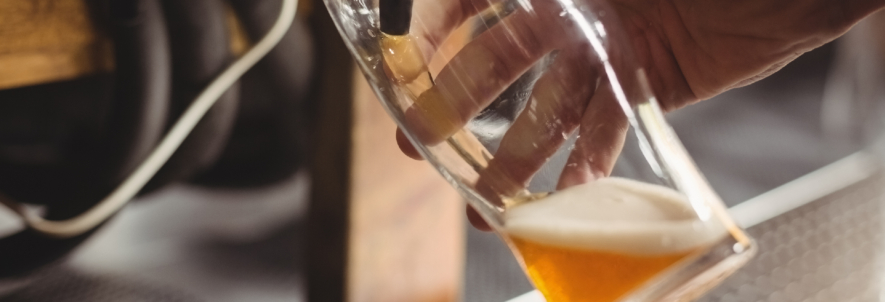
CO2 is a colorless, odorless, tasteless gas, meaning it can be very difficult to detect or even impossible to detect if something were to go awry. Yet, a CO2 gas leak in an enclosed space with minimal ventilation can be dangerous - even deadly. When you consider that CO2 is normally stored in walk-in coolers or freezers, it could be a recipe for trouble in the event of a leak.
This post covers the role of CO2 in draught systems, the dangers of CO2 in the event of a gas leak, and what breweries and distilleries can do to keep their operations safe. Read on to learn more about draught line safety and the measures you should be implementing in your brewery or distillery:
The Role of CO2 in Draught Systems
CO2 plays a role in draught systems at breweries and distilleries when it comes to pushing product from the keg or the barrel to the glass. The draught system relies on gas, which pushes the beer from the keg through a valve to flow through the draught system and to the glass.
CO2 is commonly used because this gas naturally occurs in beer. This means that it does more than just act as the guide from the keg to the glass, but it also helps maintain carbonation levels in beer and keeps it fresh.
Air compressors were formerly used as the main method of pushing beer from keg to glass, but this method was discontinued due to issues with degrading the quality of the beer. It was discovered that the beer would go flat and stale when air compressors were used. Today, most breweries or distilleries use either CO2 or nitrogen (or a blend of both) - and the supply is normally stored in a refrigerated space, like a walk-in cooler.
Health and Safety Risks of Handling CO2
CO2 is an odorless, tasteless, colorless gas that's normally a byproduct of energy production. In breweries and distilleries, it's typically contained in 5, 10 or 20-pound cylinders. Bulk CO2 tanks are also available, usually for larger breweries or for dispensing beer at sports stadiums. These tanks integrate directly into the draught system.
There are various dangers to keeping and handling CO2 within these environments. For example:
- Asphyxia: This is when someone is deprived of oxygen, which can result in unconsciousness and potentially suffocation. A CO2 leak in a confined space could pose a serious risk to the health and safety of anyone in or around the space. There have been several reports of CO2 leaks in coolers and employees suffering asphyxiation.
- Frostbite: If CO2 escapes quickly from the source of a leak, it's often discharged at sub-zero temperatures. If it comes into contact with any exposed part of an individual's body, it can cause frostbite.
- Explosions: If CO2 is stored as a compressed gas, there's the risk of an explosion. CO2 canister explosion is most common when the canisters are either overfilled or exposed to extreme conditions.
Safety Measures for Handling CO2
The good news for facilities that work with and handle CO2 is that numerous best practices can be implemented to keep people and property safe. Here's a look at some of the common safety measures to consider:
- CO2 detection alarms and monitors: This is one of the most affordable and cost-effective preventative measures that property managers and business owners should consider. These alarms are small and compact and will alert people of unsafe CO2 levels in the areas where they're installed, similar to how a smoke detector or carbon monoxide detector works. Test them on an annual basis to ensure they're still functioning properly.
- Ventilation: CO2 canisters and supplies tend to be stored in walk-in coolers or freezers. These also tend to be the most dangerous areas to succumb to exposure from a leak due to the small, confined space. One way to help prevent overexposure is to improve ventilation in coolers and other storage areas. Installing fans, vents, and/or an exhaust system helps reduce the buildup of harmful gas concentrations within the fridge or freezer.
- Properly functioning exit doors: Easy entry and exit are a must for coolers or other places where CO2 canisters are stored. CO2 exposure can be made much worse if an individual can't adequately exit the cooler where the leak is occurring. Consider using a "buddy system" when working in enclosed spaces. This ensures another person is observing their partner’s health for signs of distress and ensures a safe, unobstructed entry or exit.
- Secure storage: CO2 canisters should always be secured to avoid them being inadvertently knocked over. If they're knocked over, tripped on, dented, or damaged in any way, leaks are more likely to occur from the wear and tear.
PPE for CO2 Handling
Draught line protective clothing protects workers from hazards related to CO2. This protective clothing includes:
- Skin protection: Exposure to the sub-zero temperatures of a CO2 leak could cause skin damage and frostbite. Insulated protective clothing is a must if there's a risk of coming into contact with refrigerated gas.
- Eye and face protection: Chemical safety goggles can help protect the eyes and face from exposure to CO2 gas leaks, cleaning chemicals, and more.
- Respiratory protection: A properly fitting (i.e., fit tested) NIOSH respirator can help provide respiratory protection in the event of a known or suspected CO2 gas leak.
- Hand protection: In addition to the eyes, face, and skin, it's also important to protect the hands from the hazards that a refrigerated gas leak can pose, like frostbite. Insulated gloves help protect the hands from extreme temperatures.
If your business handles and manages CO2, make sure that your safety best practices are up to par. Take the time to identify all processes and tasks where exposure may occur, and work to eliminate them. If the threat cannot be eliminated, the use of PPE and protective clothing must be used.